

|
|

 LOWER MANHATTAN TOURS Professor Silvestri's Discover New York Classes 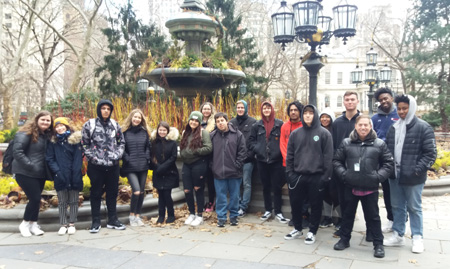
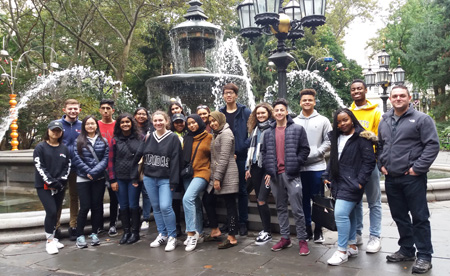
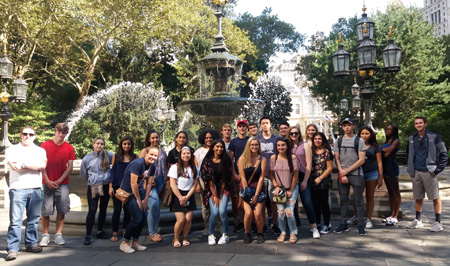
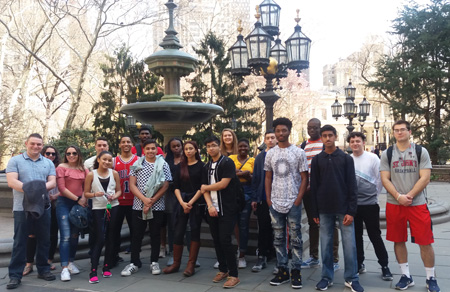
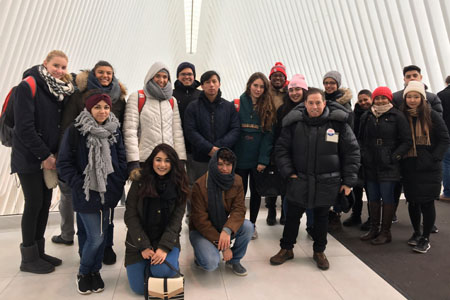
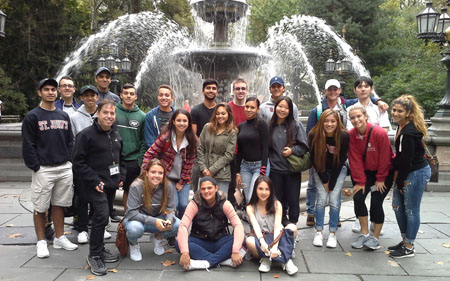
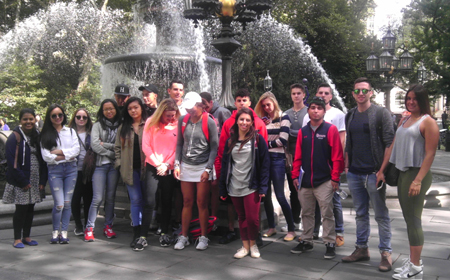
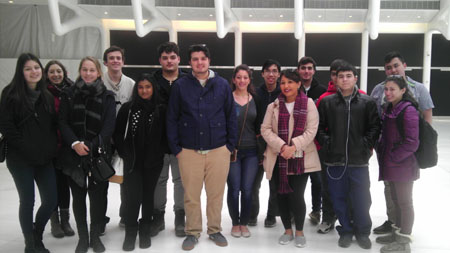
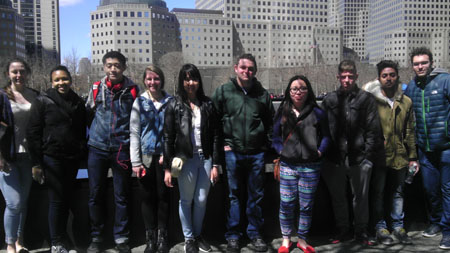
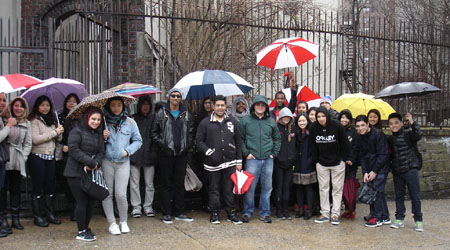
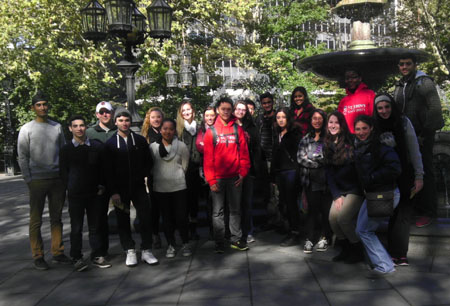
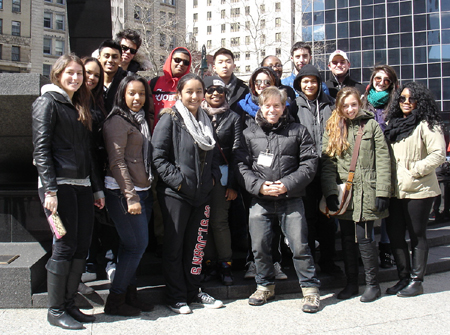 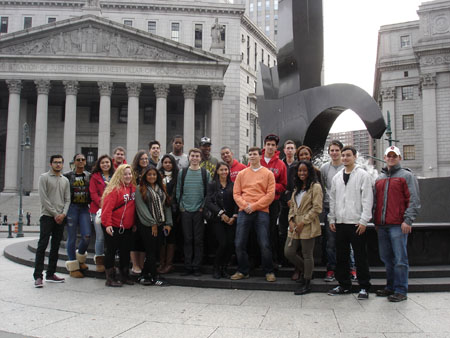
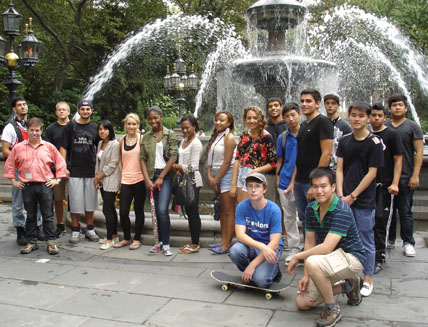 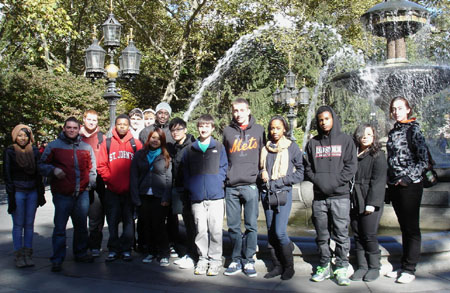 CEMETERY TO CEMETERY TOUR TIME:10:30 am - Noon pm STARTING POINT:Chambers Street and Broadway (Southeast corner next to the Park fence. The following subways are nearby: A,C,E,R,1,2,3,4,5,6,J,Z) ENDING POINT: We will end near the World Trade Center. 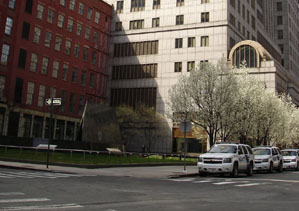
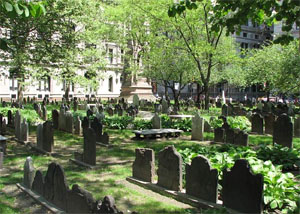
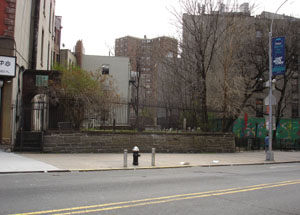 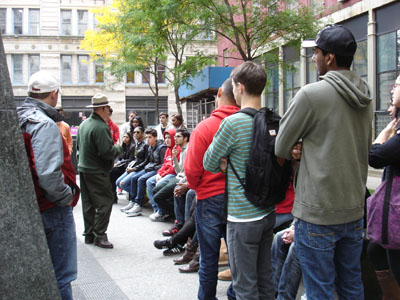 Professor Silvestri's 2013 Fall Class at the African American Burial Grounds OBJECTIVE OF TOUR: To expose the students the various places and history of Lower Manhattan to excite them to follow up with future visits on their own. The Walk focuses on the themes of immigration, race/ethnicity, religion, wealth and poverty, civil rights and the impact of New York's urban planning on the nation's built-out environment. Special attention will be given to all of the immigrants who came to our city from the beginning of New Amsterdam until today. The Tour also focuses on the World Trade Center and the changes that occurred over the past decade. ROUTE: This TOUR starts at the corner of Chambers Street and Broadway and then travels up to the African Burial Grounds, then by the Brooklyn Bridge and City Hall Park, then by the new Transit Hub and World Trade Center, and Zuccotti Park (Occupy Wall Street) and ends at the World Trade Center. There will be public bathroom facilities available at the World Trade Center Oculus. PLACES OF INTEREST THAT WE WILL PASS ON TOUR #1 (City Hall - WTC): 1. City Hall Park including the Tweed Courthouse and City Hall and the Fountain. We will also see the Municipal Building, Pace University, Newspaper Row and the Brooklyn Bridge. We will also go to the African Burial Grounds and Museum and explain the impact of slavery on New York City. We will discuss the history of both of the cemeteries that we visited. While near the Courthouses at Foley Square we will discuss the "5 Points" area and the immigrants living in those tenements. 2. We will see several of the World's Tallest Buildings, including the Woolworth Building, "J&R" Building and even the 10 story Corbin Building. 3. We will see the new Fulton Street Transit Hub. 4. We will go past St. Paul's Chapel and Cemetery (where George Washington had a pew and his prayer book is still there). 5. We will pass the former AT&T Building. 6. We will go to the World Trade Center site and discuss the current and future development and discuss what it was like on 9/11 and the aftermath. 7. We will see the Temporary Morgue set up after 9/11. 8. We can see where Occupy Wall Street began. 9. We can explore NYC's private public parks. 10. We can pass where zoning started in the United States (and how the desire to live in exclusive areas spearheaded these regulations) and end up at Wall Street and Trinity Church. BIO OF TOUR GUIDE Richard Landman, AICP, Attorney Emeritus, Licensed Sightseeing Tour Guide, has 3 Masters Degrees and a JD from New York Law School. He was the Director of Real Estate Development, at NYU for almost 20 years and an adjunct professor of Land Use Law at NYU�s Wagner School for 7 years, and currently teaches at New York Law School. He was the chair of Community Board#1- Manhattan�s Landmark Committee, Tribeca Committee and Planning and Infrastructure Committee over the years. Earlier in his career he was the Executive Director of Real Estate Development for the City of New York�s Division of Real Property. 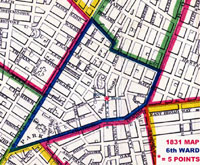 Map of the 1831 Map of the "5 Points" Saturday, March 29, 2014 TIME:10:30 am - Noon pm STARTING POINT:Chambers Street and Broadway (Southeast corner next to the Park fence. The following subways are nearby: A,C,E,R,1,2,3,4,5,6,J,Z) ENDING POINT: We will end near the Tenement Museum on Orchard Street near the "F" Train stop on Delancey Street. 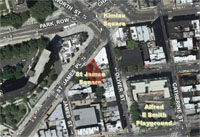 View of the location of the Shearith Israel Cemetery OBJECTIVE OF TOUR: To expose the students the various places and history of Lower Manhattan to excite them to follow up with future visits on their own. The Walk focuses on the themes of immigration, race/ethnicity, religion, wealth and poverty, civil rights and the impact of New York's urban planning on the nation's built-out environment. Special attention will be given to the African Americans and other immigrants who came to our city; including but not limited to the Italians, Jews, Asians, and Irish. The "Talk" will start with the Puritans and Juan Rodgrigez to show how New York City's history is different from other settlements and colonies; and how our diverse population and real freedom of religion and thought permitted us to grow this economic engine into what he see today.  Tenement Museum of the Lower East Side will be our final stop." This TOUR starts at the corner of Chambers Street and Broadway and then travels up to the African Burial Grounds, then to Collect Pond, the 5 Points, the Jewish Cemetery, through Little Italy, Chinatown, and ends at the Tenement Museum near Delancey Street. There will be public bathroom facilities available at Starbucks on Chambers Street at the beginning of the Tour. 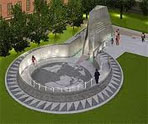 We will pass the African American Burial Ground, to discuss forced migration to New York.   We will pass the Sherith Israel Jewish Cemetery. 1. City Hall Park including the Tweed Courthouse and City Hall and the Fountain. We will also see the Municipal Building, Pace University, Newspaper Row and the Brooklyn Bridge. We will also go to the African Burial Grounds and Museum and explain the impact of slavery on New York City. 2. While near the Courthouses at Foley Square we will discuss Collect Pond. 3. We will find the original "5 Points" Intersection. 4. We will see the Jewish Cemetery from Shearith Israel. 5. We will walk through Chinatown and Little Italy up towards the Eldridge Street Synagogue. 6. We will end at the Tenement Museum on Orchard Street near Delancey Street. 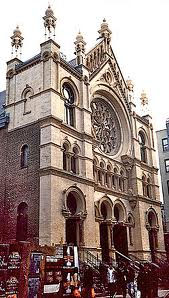 We will pass by the Eldridge Street Synagogue and Museum.  Professor Silvestri's 2013 Fall Class at the African American Burial Grounds |
| Past Tours including a tour called Cemetery to Cemetery where we viewed the African American Burial Grounds and compared it to the Trinity Church Cemetery and also discuss the World Trade Center area. Another Tour was on the life of the various groups living in New Amsterdam. We discussed their lives while we walked down the street of south of Wall Street. |
 The Municipal Building with Civic Fame on top. The Municipal Building with Civic Fame on top.
|
No longer a courthouse, the former "Boss Tweed Courthouse" was known for its corruption and cost overruns more than anything else. It is now used by the Dept. of Education.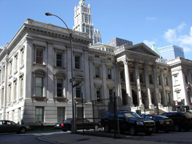 |
The Sun Building now contains the Department of Buildings, but was once the home of the Sun Newspaper and before that a Department Store. Mrs. Lincoln used to love to shop there.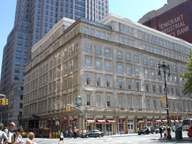 |
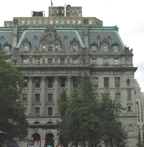 The Surrogates Court Building contains the Muncipal Archives and the information about deeds, etc. and probate.
The Surrogates Court Building contains the Muncipal Archives and the information about deeds, etc. and probate. |
When excavating the federal office building they uncovered bones and discovered the African American burial grounds for free blacks and slaves. Only white Christians could be buried in the city limits at the Trinity Church cemetery. The Jews were buried near present day James Street.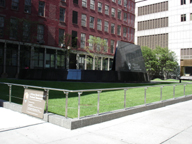 |
 Freed and Slave African Americans were buried at this location. There is also a Memorial and Museum that is worth exploring. Freed and Slave African Americans were buried at this location. There is also a Memorial and Museum that is worth exploring.
|
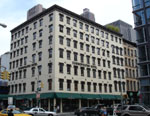 This Hotel goes back to the times of President Lincoln (it was called the Girard House until 1869. Contrary to popular belief, President Lincoln slept at the Astor House in 1860 and 1861; and not at the Cosmopolitan Hotel. This Hotel goes back to the times of President Lincoln (it was called the Girard House until 1869. Contrary to popular belief, President Lincoln slept at the Astor House in 1860 and 1861; and not at the Cosmopolitan Hotel.
|
 Statue of Ben Franklin in front of Pace University. Statue of Ben Franklin in front of Pace University.
|
 I have found the word German in another location in Lower Manhattan. It is at the entrance to the Brooklyn Bridge. It relates the story of the building of the bridge and how John Roebling was a German Immigrant. This is a new sign that was installed recently. |
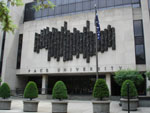 Pace University. Pace University.
|
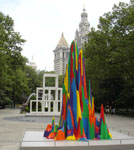 City Hall Park with a public art display. City Hall Park with a public art display.
|
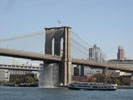 We will pass City Hall Park and take a look at the Brooklyn Bridge. We will pass City Hall Park and take a look at the Brooklyn Bridge. |
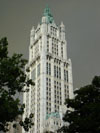 We pass the Woolworth Building, which was the tallest building in the world until the Chrysler Building surpassed it. It was known as the Cathedral of Commerce. We pass the Woolworth Building, which was the tallest building in the world until the Chrysler Building surpassed it. It was known as the Cathedral of Commerce.
|
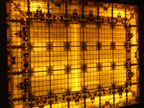 Do you where this building is located? This is is the only place where I was able to find the word "German" on or in a building that was created in the 20th Century. While there are many buildings in the East Village (Kleine Deutschland) from the 19th Century with German inscriptions, I am still searching for anything German in Manhattan from after World War I. The stained glass skylight (was originally built as a functioning skylight until the additional floor was added over the skylight in 1919) was created by Heineke and Bowen, the same people who made the ceiling tile. The elevator door covers are by Tiffany. The skylight contains the date 1879 which was when the Woolworth company began and 1913 when the building was completed. It also lists the major trading countries in the world at the time. |
 Here you still see the words, "German Empire" (and the Eagle) on the periphery of the skylight with other countries such as France, United States, Russia, Great Britain, Argentina, Austria, Spain, Italy, Brazil, Japan and China. |
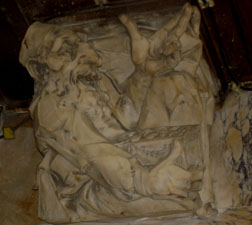 There is also a stereotypical gargoyle of a Jewish banker, something that would in years to come become a frequent topic of ridicule by Nazis such as Julius Streicher in his Sturmer Newspaper. I have not found a definitive story about who this gargoyle represents. |
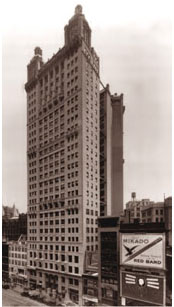 The building that now contains the "J & R Music World" was once the tallest building in the world, and the top cupolas were used for tourists to see the views. The building that now contains the "J & R Music World" was once the tallest building in the world, and the top cupolas were used for tourists to see the views.
|
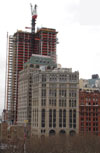 On the former Urban Renewal site near City Hall and Pace University, we will pass the New York by Frank Gehry luxury apartment house under construction. On the former Urban Renewal site near City Hall and Pace University, we will pass the New York by Frank Gehry luxury apartment house under construction.
|
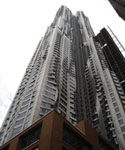 This is the new public elementary school and luxury rental building called New York by Gehry. This is the finished southern exposure of the "New York by Gehry" apartment house. This facade does not wave like the other ones. This is the new public elementary school and luxury rental building called New York by Gehry. This is the finished southern exposure of the "New York by Gehry" apartment house. This facade does not wave like the other ones.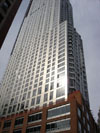
|
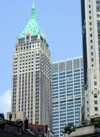 We will walk down to Wall Street and see the building that was almost the tallest in the world and see how the streetscape has changed since 9/11. We will walk down to Wall Street and see the building that was almost the tallest in the world and see how the streetscape has changed since 9/11.
|
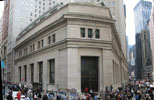 We will go by the building with no signage and which "terrorists" bombed. If you didn't know who owned this building, then you had no business going in. We will go by the building with no signage and which "terrorists" bombed. If you didn't know who owned this building, then you had no business going in.
|
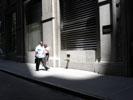 Now we will walk down Pine Street and see how the sun actually hits the ground on June 21st at noon during the summer solstice. The woman smoking walked along with the sunlight during her lunch break smoke. Now we will walk down Pine Street and see how the sun actually hits the ground on June 21st at noon during the summer solstice. The woman smoking walked along with the sunlight during her lunch break smoke.
|
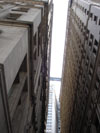 Looking skywards on Pine Street you can really understand the need for zoning set-backs. Looking skywards on Pine Street you can really understand the need for zoning set-backs.
|
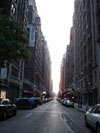 After 1916, the Zoning mandated set-backs so that the sunlight could reach the sidewalks for most of the day. This is an example of set-backs from midtown. After 1916, the Zoning mandated set-backs so that the sunlight could reach the sidewalks for most of the day. This is an example of set-backs from midtown.
|
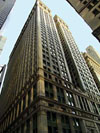 This is the Equitable Building which showed the public what could happen if buildings were not regulated. In 1916, the City of New York created height and set-back zoning regulations due to this building. This is the Equitable Building which showed the public what could happen if buildings were not regulated. In 1916, the City of New York created height and set-back zoning regulations due to this building.
|
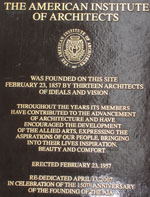 We will see where the American Institute of Architects was founded. We will see where the American Institute of Architects was founded.
|
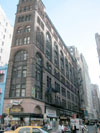 We pass the Corbin Building, which was the tallest building in the world when it was constructed. It is next to the Fulton Transportation Hub under construction. We pass the Corbin Building, which was the tallest building in the world when it was constructed. It is next to the Fulton Transportation Hub under construction.
|
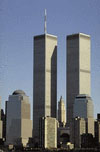 WORLD TRADE CENTER AREA |
 I took this photo in September 2001 showing "Ground Zero". Living in Southern Tribeca for over 30 years, I was displaced from my apartment for approximately one month, and returned home in October. The picture to the right is of me dressing up to go to Ground Zero in September. I took this photo in September 2001 showing "Ground Zero". Living in Southern Tribeca for over 30 years, I was displaced from my apartment for approximately one month, and returned home in October. The picture to the right is of me dressing up to go to Ground Zero in September.
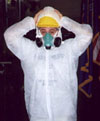 |
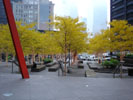 This is a public plaza created by the transfer of development rights. The bulk was transferred to the large building across the street. There was a Choc Full O' Nuts restaurant on the ground floor of the previous building that was permitted to stay until its lease ran out. It looked like an ancient ruin since the top floors were removed. This is a public plaza created by the transfer of development rights. The bulk was transferred to the large building across the street. There was a Choc Full O' Nuts restaurant on the ground floor of the previous building that was permitted to stay until its lease ran out. It looked like an ancient ruin since the top floors were removed.
|
|
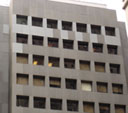 This building shook so much on 9/11 that all of the granite panels had to be removed from the facade. You can see that the newer replacements are of a different color. This building shook so much on 9/11 that all of the granite panels had to be removed from the facade. You can see that the newer replacements are of a different color.
|
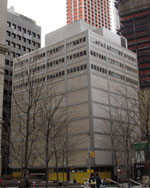 This building had less damage even though it was closer to the WTC because it had few windows on the northern facade. This building had less damage even though it was closer to the WTC because it had few windows on the northern facade.
|
 On September 12, 2001 at 7 a.m. the sky was totally blue without a cloud in sight, except for the area over where the World Trade Centers once stood. This cloud is due to the dust from the destruction. 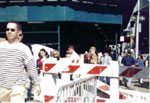 Around October the neighborhood became a "tourist attraction" with masses of people going down to the see "Ground Zero". These people are passing right in front of my apartment house near Chambers Street. |
 My neighborhood became a "Gated Community" with barricades and police checking all ID's as you entered the area in September. Residents were permitted back to start cleaning up their apartments and other authorized personnel were given access.  What most people didn't know was that the electricity was shut off for the entire neighborhood when 7 WTC fell. Con Edison there ran an entire new system of conduit above ground in orange wooden boxes. Most people just walked over them and never realized what they were.  This is a close-up of the electrical power lines in the orange wooden boxes as seen from my window. |
 We will discuss how this building shook so much on 9/11 that every one of the granite panels had to be removed and either replaced or returned to the facade. You can see that certain panels are not of the same color as the rest. |
 This building protected the one to the south. It had minor damage because it has very few windows (some broke) on its northern facade. |
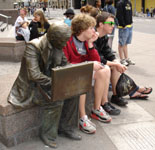 We will be able to sit next to the sculpture that was already situated in the park and was covered with debris. I don't even know if the young people realize that the man sitting next to them is made of bronze. |
 We will discuss the location of the temporary Morgue that was set up by the federal government. |
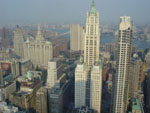 View from 7 World Trade Center of Lower Manhattan. |
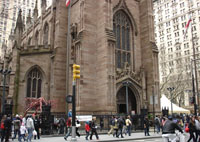 Trinity Church at Wall Street is usually the terminal stop or beginning of tours. One can see the grave of Alexander Hamilton and Robert Fulton; and it is also a wonderful place for a rest stop.
Trinity Church at Wall Street is usually the terminal stop or beginning of tours. One can see the grave of Alexander Hamilton and Robert Fulton; and it is also a wonderful place for a rest stop.
|
|
NEW AMSTERDAM TOUR This is an alternative Route that could be used for future Tours... |
This tour will include the story of how many different groups of immigrants came to New Amsterdam with specific attention given to religious freedom and the lives of free and slave Africans, and sexual minorities. |
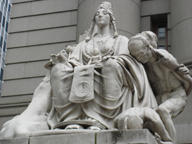 If it is not raining, we will meet at the base of Asia in front of the former U.S. Customs House on Bowling Green. (Current site of the Museum of the American Indian and former site of Fort Amsterdam.) If it is not raining, we will meet at the base of Asia in front of the former U.S. Customs House on Bowling Green. (Current site of the Museum of the American Indian and former site of Fort Amsterdam.)
|
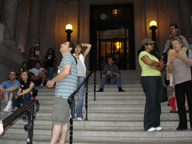 If there is a slight drizzle, we can meet here on the stairs and I will conduct a quick lecture and see if the weather changes. Heavy rain will cancel the tour. If there is a slight drizzle, we can meet here on the stairs and I will conduct a quick lecture and see if the weather changes. Heavy rain will cancel the tour.
|
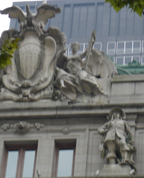 Look up at the top of the former U.S. Customs House and you can see a Dutchman, Maarten Harpertszoon Tromp (b. 1598 Holland � d. At Sea 1653), a famous Dutch admiral. At age 9, he became a sailor and at he joined the Dutch navy as a lieutenant in 1621. He became known in 1628 when as Piet Hein's flag captain, he helped capture the Spanish treasure fleet. In 1639, he blockaded and crushed a Spanish fleet in the Downs of the English Channel. This victory ended Spanish sea power. In June, 1652, he refused to lower his flag in deference to the English Admiral Robert Blake, and started the first of the Dutch Wars. That same year, he won control of the English Channel when he beat the English off Dungeness, but he was forced to withdraw. His inferior fleet lost 20 ships in a battle near Gabbard Shoal in 1653.
He then joined with his rival Witte de Witt and attacked the English off Scheveningenin in August of 1653. They were defeated and Tromp was killed in the battle by a sharpshooter. It was the last major conflict of the war. Tromp's death hurt the Dutch navy and hurt the Orange cause, which had sought to defeat England and restore the Stuart monarchy. One of his sons, Cornelis Tromp, became a Rear Admiral in the Dutch navy.
The sculpture is by Louis Saint-Gaudens. Look up at the top of the former U.S. Customs House and you can see a Dutchman, Maarten Harpertszoon Tromp (b. 1598 Holland � d. At Sea 1653), a famous Dutch admiral. At age 9, he became a sailor and at he joined the Dutch navy as a lieutenant in 1621. He became known in 1628 when as Piet Hein's flag captain, he helped capture the Spanish treasure fleet. In 1639, he blockaded and crushed a Spanish fleet in the Downs of the English Channel. This victory ended Spanish sea power. In June, 1652, he refused to lower his flag in deference to the English Admiral Robert Blake, and started the first of the Dutch Wars. That same year, he won control of the English Channel when he beat the English off Dungeness, but he was forced to withdraw. His inferior fleet lost 20 ships in a battle near Gabbard Shoal in 1653.
He then joined with his rival Witte de Witt and attacked the English off Scheveningenin in August of 1653. They were defeated and Tromp was killed in the battle by a sharpshooter. It was the last major conflict of the war. Tromp's death hurt the Dutch navy and hurt the Orange cause, which had sought to defeat England and restore the Stuart monarchy. One of his sons, Cornelis Tromp, became a Rear Admiral in the Dutch navy.
The sculpture is by Louis Saint-Gaudens.
|
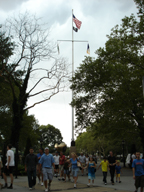 Flagpole honoring the 350th anniversary of New Amsterdam in Battery Park. Flagpole honoring the 350th anniversary of New Amsterdam in Battery Park. Be careful where you step... We will see the sidewalk with the engraving over the ticker tape parade for Queen Juliana of the Netherlands' visit to NYC in 1952. Be careful where you step... We will see the sidewalk with the engraving over the ticker tape parade for Queen Juliana of the Netherlands' visit to NYC in 1952.
|
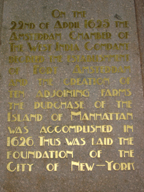 Wording on the base of the flagpole about the "purchase" of Manhattan Island. Wording on the base of the flagpole about the "purchase" of Manhattan Island.
|
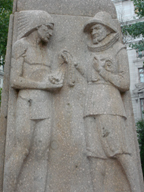 Also on the base of the flagpole, commemorating the real property transaction of the Native Americans and Peter Minuit. We will discuss whether an actual contract or deed was ever contemplated and if a "meeting of the minds" actually occurred. Was the Native American advised by counsel as to what the Dutch man saying? What if the Native American thought that he was getting a gift of trinkets in order to welcome a new tribe into his community or to become a trading partner, etc.? Also on the base of the flagpole, commemorating the real property transaction of the Native Americans and Peter Minuit. We will discuss whether an actual contract or deed was ever contemplated and if a "meeting of the minds" actually occurred. Was the Native American advised by counsel as to what the Dutch man saying? What if the Native American thought that he was getting a gift of trinkets in order to welcome a new tribe into his community or to become a trading partner, etc.?
|
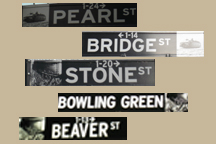 The current Street Names still reflect the activities of New Amsterdam. Stone Street (where the brewery was built and the street was paved with cobble stones) was made of stone, and Bridge Street passed over a creek, Bowling Green was the public area, Beaver was one of the major economic products, Pearl Street was the waterfront at the time and was where people went pearling. Words like cookies or boss, places like Brooklyn, Bronx, Yonkers, Gansevoort, Harlem, Utrecht, Staten Island, and characters like Santa Claus all have Dutch roots, let alone family names like Vanderbilt, Roosevelt, Van Buren, etc. The current Street Names still reflect the activities of New Amsterdam. Stone Street (where the brewery was built and the street was paved with cobble stones) was made of stone, and Bridge Street passed over a creek, Bowling Green was the public area, Beaver was one of the major economic products, Pearl Street was the waterfront at the time and was where people went pearling. Words like cookies or boss, places like Brooklyn, Bronx, Yonkers, Gansevoort, Harlem, Utrecht, Staten Island, and characters like Santa Claus all have Dutch roots, let alone family names like Vanderbilt, Roosevelt, Van Buren, etc.
|
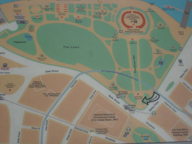 This is a map located in Battery Park which shows the original boundaries of New Amsterdam. Pearl Street was the southern boundary and Greenwich Street up to Wall Street made up the rest of the boundaries. This is a map located in Battery Park which shows the original boundaries of New Amsterdam. Pearl Street was the southern boundary and Greenwich Street up to Wall Street made up the rest of the boundaries.
|
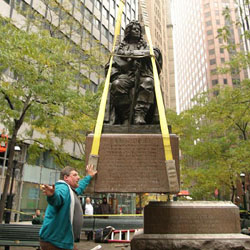 Where is the Statue of Mayor Abraham De Peyster? Let's try to get him out of the Closet! |
For more information Click Here-- About the Warehousing of the New Amsterdam born Mayor of New York City.The Statue of Mayor De Peyster was originally where King George's Statue stood in Bowling Green and then was moved to Hannover Square. But when Hannover Square was planned for renovation as an English themed square, the Statue was moved into storage and was approved to be placed in City Hall Park. So far, it is still in storage. 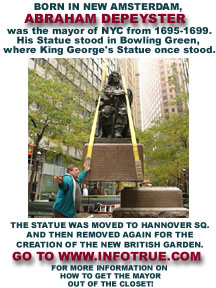 |
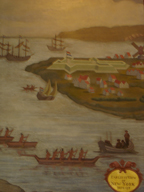 The following three murals are located in the NYS Supreme Court at 60 Centre Street on the 4th floor Jury Room by Robert K. Ryland during the WPA. This mural represents the pre-European view of the island. The following three murals are located in the NYS Supreme Court at 60 Centre Street on the 4th floor Jury Room by Robert K. Ryland during the WPA. This mural represents the pre-European view of the island.
|
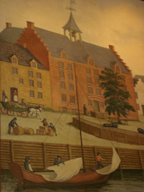 This mural represents the "City Hall" of New Amsterdam. This mural represents the "City Hall" of New Amsterdam. |
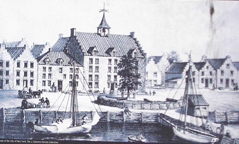 This is another representation of the same building. You will be able to see the dimensions of the footprint of this building at the Goldman Sachs plaza near Stone Street. This is another representation of the same building. You will be able to see the dimensions of the footprint of this building at the Goldman Sachs plaza near Stone Street.
|
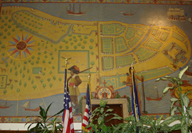 This mural represents a map of the early New Amsterdam colony street patterns. This mural represents a map of the early New Amsterdam colony street patterns.
|
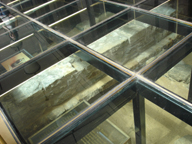 When the Goldman Sachs Building was excavated they discovered the foundations and cisterns from the early era of New York City. But Lovelace Tavern was built in 1670, which would be after New Amsterdam, but was there during the Dutch period of New Orange. When the Goldman Sachs Building was excavated they discovered the foundations and cisterns from the early era of New York City. But Lovelace Tavern was built in 1670, which would be after New Amsterdam, but was there during the Dutch period of New Orange.
|
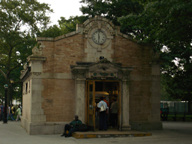 Anything that looks Dutch is not from New Amsterdam, but constructed years or centuries later to be reminiscent of the Dutch presence. Peter Minuit never took the subway. Anything that looks Dutch is not from New Amsterdam, but constructed years or centuries later to be reminiscent of the Dutch presence. Peter Minuit never took the subway.
|
 This nearly ten-foot-tall granite stele at the northwest corner of Battery Park by the Castle Clinton National Monument was designed by noted architect Henry Bacon. The monument and its gilded inscription commemorates the Walloon Settlers, a group of 32 Belgian Huguenot families who joined the Dutch in 1624 on the ship Nieu Nederland (�New Netherland�) to colonize New Amsterdam. Bacon also designed Washington's Lincoln Memorial and Williamsburg's Metropolitan Pool.
The Walloons were natives of the County of Hainaut in Belgium who had fled to nearby Holland to escape religious persecution. Made to feel unwelcome in Holland, the Walloons, led by Jesse de Forest, first appealed to the British in 1621 for permission to settle in Virginia. When was denied, they petitioned the Dutch West India Company to allow them to settle in the Dutch-controlled colony of New Amsterdam. Their application was granted and the Walloons left Holland in March 1624, landing in New York on May 20, 1624. One should also know that other groups fled to Holland before coming to the New World, such as the Pilgrims.
This nearly ten-foot-tall granite stele at the northwest corner of Battery Park by the Castle Clinton National Monument was designed by noted architect Henry Bacon. The monument and its gilded inscription commemorates the Walloon Settlers, a group of 32 Belgian Huguenot families who joined the Dutch in 1624 on the ship Nieu Nederland (�New Netherland�) to colonize New Amsterdam. Bacon also designed Washington's Lincoln Memorial and Williamsburg's Metropolitan Pool.
The Walloons were natives of the County of Hainaut in Belgium who had fled to nearby Holland to escape religious persecution. Made to feel unwelcome in Holland, the Walloons, led by Jesse de Forest, first appealed to the British in 1621 for permission to settle in Virginia. When was denied, they petitioned the Dutch West India Company to allow them to settle in the Dutch-controlled colony of New Amsterdam. Their application was granted and the Walloons left Holland in March 1624, landing in New York on May 20, 1624. One should also know that other groups fled to Holland before coming to the New World, such as the Pilgrims.
|
 We will discuss the Ashkenazi and Sephardic Jews that came to New Amsterdam in the summer 1654 and how differently they were treated. While Peter Stuyvesant would not grant the Jews the right to build a synagogue, they met in a building on Mill Street (South William Street) until the first synagogue was built under the English rule in 1730 in the location of this present day garage. For more information about the early Jewish history from 1654 on, click here We will discuss the Ashkenazi and Sephardic Jews that came to New Amsterdam in the summer 1654 and how differently they were treated. While Peter Stuyvesant would not grant the Jews the right to build a synagogue, they met in a building on Mill Street (South William Street) until the first synagogue was built under the English rule in 1730 in the location of this present day garage. For more information about the early Jewish history from 1654 on, click here In 1657 a group of Dutch settlers fought to permit Quakers to reside in New Netherlands. For more information about the Flushing Remonstrance, click here. |
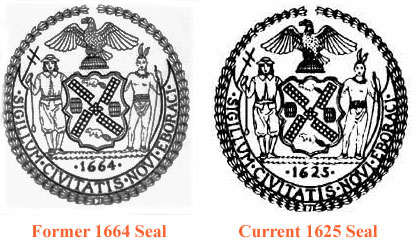 The date was changed on the official seal and flag of the City of New York. It used to be 1664 and now it is 1625 to reflect New Amsterdam as its European origins. |
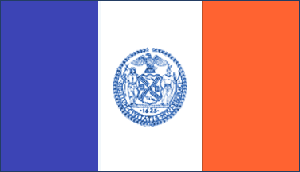 You can see the dutch influence in our official city flag. Notice the 1625 date.  Notice the 1626 Date on the Municipal Building. |
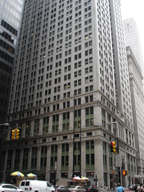 When elevators and steel allowed 120 Broadway to rise so tall that it blocked the sunlight on the sidewalks of the narrow streets in Lower Manhattan, NYC created Zoning Laws (set backs, sky exposure plane, etc.) in 1916 which then spread across the country. When elevators and steel allowed 120 Broadway to rise so tall that it blocked the sunlight on the sidewalks of the narrow streets in Lower Manhattan, NYC created Zoning Laws (set backs, sky exposure plane, etc.) in 1916 which then spread across the country.  This is part of a NYC tax map showing how the deep and narrow 25 foot lots still remain since the Dutch used this concept on the canals in Amsterdam. |
Weather permitting, the tour will wind its way up to Pine Street (one block north of the northern boundary of New Amsterdam at Wall Street), and over to Broadway. Topics discussed on the walk will include the origins of America's Zoning laws such as the need for set backs, narrow and winding street patterns, taxation laws based on narrow 25 foot lots, as well as America's basis for religious freedom and where the Jews and African-Americans are buried. This tour ends at Trinity Church, but I will walk up to the World Trade Center after the tour and continue my talk if anyone so desires. 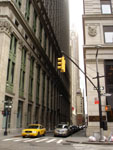
|
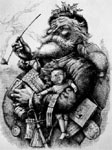 Image of Saint Nicholas Originally called �Saint Nicholas� by the Dutch, the pronunciation sounded more like �Sint Nikolass�. The name was reshaped for non-Dutch tongues, and evolved into �Sinterklass�, and finally into �Santa Claus�. Did you ever wonder how the U.S. Congress created Christmas as a secular national holiday in 1870 and how Santa Claus came into being the American symbol of Christmas? |
We will discuss the life of Harmen van den Bogaert, a doctor and married man with 4 children, who helped the colony by negotiating with the Native Indians, but who was caught with his male African servant Tobias in an intimate situation and was arrested and died for that act. Homophobia was alive and well in the New World too. We will also discuss some heroes of the New World that are left out of our English centric text books such as Adriaen van der Donck a real hero for our civil rights. In addition to discussing how the inhabitants of New Amsterdam (Dutch, English, French, Jews, Quakers, Finns, Germans, Africans, Native Americans, etc.) convinced their Governor Peter Stuyvesant to surrender to the English rather than have their city destroyed, we will also discuss how in August 1673, the English Governor and the inhabitants of New York City, saw Dutch war ships enter New York Harbor and stood by and watched the English flag come down as the city was returned to Dutch rule and called New Orange for a year, until it once again became English, years before the American Revolution. |
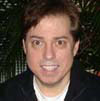 ABOUT THE TOUR GUIDE
ABOUT THE TOUR GUIDE
The Standard Rate for a Large Group Tour (usually for up to 25 persons) which follows one of the existing listed Tours is $300. The lecture can be modified to meet your group's needs. Each Tour is approximately one and a half hours long. INSURANCE Clients assume all liability and risks during the walks. Please be vigilant when crossing the streets. CANCELLATIONS Should the tour guide cancel the tour, then a total refund of any deposit will be given and no fee will be charged for the tour. No consequential damages will be offered. However, if the tour was an individualized tour that required specific research, then the deposit from the group is not refundable, should the group decide to cancel. But the rest of the fee will be forgiven should the group wish to cancel the tour. Please give at least 24 hours notice. |